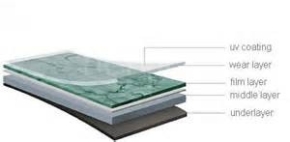What Exactly is Luxury Vinyl Tile?
What Exactly is Luxury Vinyl Tile
In the flooring world, there has always been a vinyl tile in one form or another. Today, the vinyl tile category continues to remain popular today, and continues to be the fastest growing market segment with double digit growth last year. LVT (Luxury Vinyl Tile), which offers 3D printing technology which adds depth and realism, durability, with a high performance wearlayer to a vinyl tile product. LVT offers the option of a less permanent floor than wood or ceramic tile, especially with the growing popularity of floating LVT floors. When a consumer selects a wood or ceramic floor, they should really be in love with it, as it will probably be in the home for a very long time. Whereas, LVT offers the option of changing the room design much easier.
The term Luxury Vinyl Tile (LVT), is not recognized as a separate flooring category by ASTM, but it is a term that known all over the flooring industry. ASTM International, is an international stan- dards organization that develops and publishes voluntary consensus technical standards for a wide range of materials, products, systems, and services.
ASTM has industry standards for resilient flooring and there are only two products in the category of Vinyl Tile;
Vinyl Composition Floor Tile (VCT) ASTM F 1066, and
Solid Vinyl Floor Tile (SVT) ASTM F1066.
There is no ASTM Specification for Luxury Vinyl Tile. The difference is that Solid Vinyl Floor Tile has a minimum vinyl or binder content. Products with a vinyl or binder content of 34% or higher are classified as Solid Vinyl Floor Tile and products less than 34% vinyl or binder content are VCT.
ASTM F 1700, Standard Specification for Solid Vinyl Floor Tile classifies Solid Vinyl Tile in three categories;
Class I Monolithic, which means through color tile with no backing
Class II Surface Decorated, which usually means an “inlaid” type tile with a backing
Class III, Printed Film Vinyl Tile, which is a photographic print film with a clear vinyl wearlayer and a backing system. A minimum wearlayer thickness of 0.020″ (20 mils) will classify the Class III product as Commercial.
Type A – Smooth Surface
Type B – Embossed Surface
Physical Property Requirements Tests
Size
Thickness
Squareness
Residual Indentation
Flexibility
Dimensional Stability (important requirement)
Resistance to Chemicals
Solid Vinyl Tile installation is usually different from VCT installations. Clear Thin Spread Adhesives are mostly used for VCT and have long working (up to 24 hours). Trowel the adhesive over large areas, and allow it to dry to the touch, and there are several hours of working time to get the VCT installed. LVT (Solid Vinyl Floor) products may also able to be installed with pressure sensitive adhesive, although they are not the same adhesives as VCT, they have more binders and latex to bond to the added vinyl content and hold it into place and have shorter working times (generally up to 2 hours). Solid Vinyl Floor Tile may also be wet set or adhered using a Vinyl Spray Adhesive, depending on the application.
LVT (Solid Vinyl Floor) also offers plank and tiles with high end realistic 3D visuals that can be grouted which resembles Ceramic and Stone installations without the use of backer board and thinset. These products can be found with glue down and floating installation options.
Armstrong Alterna Reserve
Floating Groutable LVT Metroflor Aspire
LVT or Solid Vinyl Floor Tile offers several installation options which ease the installation application;
Loose Lay
Tape Systems
Clic and Locking Systems
Floating with no locking mechanism, but help in place by adhering the perimeter with
glue or tape
Glue Down
Trowel or Roll On Applied
Spray Adhesives
What differentiates one LVT (Solid Vinyl Floor Tile) from another? In my opinion, there are two factors (in order);
1. Wearlayer thickness (thickness of 20 mils or more will classify Class III product as
Commercial).
2. Installation System
Loose Lay
Glue Down
Let’s look at both scenarios;
Wearlayer thickness – the thicker the better. The wearlayer is usually a heavy film of
vinyl cover with a UV Cured Urethane wearlayer for better scuff, stain and scratch resistance. Is there a difference between a 12 mil vinyl wearlayer and a 12 mil wearlayer with a urethane coating? Definitely. Urethane provides better scuff, stain and scratch resistance. Wearlayer thickness is measured in mils.
Installation System – depending on the environment the product is being installed should determine the installation requirements of the product. For Example; if an area is subject to heavy rolling loads, and pinch points, a glue down product is a better installation option than a floating installation.
Installation issues I see within the LVT product segment are;
Loose Lay Installations – flooring is installed prior to cabinet placement. Cabinets are installed on top of floor, and floor buckles.
Lack of expansion given on floating products. Product is not given enough room to accommodate subfloor movement. Flooring is fit to tight to walls and cabinets. Think Laminate when installing LVT.
This is vinyl; it requires acclimation and a constant living temperature. When cold, it contracts. When warm, it expands. Stabilize conditions to living conditions. If conditions fluctuate, so does the product.
People think Loose Lay floors can go over anything. Fact; Loose Lay floors require as much prep if not more than a glue down floor. You can’t cover bad floor prep with LVT and get away with it.
Glue down installations requires time to dry. Cover the flooring with panels to disperse load bearing areas and pivot points to prevent flooring from moving until the adhesive as time to set up, generally 24 to 72 hours.
There are also options for sound reduction under LVT. For floating applications, most suppliers have a sound reducing membrane product for use under the LVT.
Thanks to JJ Haines for the information!




